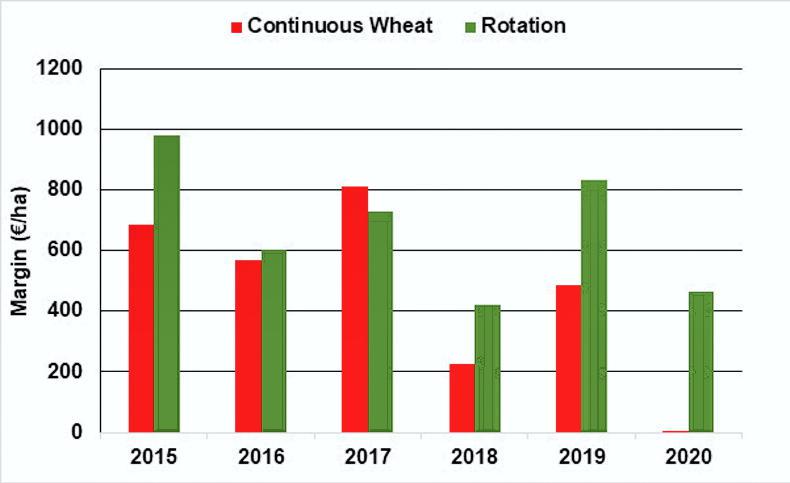Prior to the mid-1970s, most cereal crops were produced on mixed farms where grass was the main crop, resulting in fertile soils with high organic matter and healthy crop rotations.
Grass largely disappeared with increased specialisation, and many farms adopted all-cereal rotations or single-crop monoculture, with limited potato, beet or maize crops.
While this approach has some advantages, rotations that include break crops can bring benefits which contribute to profitability and production sustainability.
These include higher yields following breaks in disease cycles, more weed control options, improved labour and machinery utilisation and more diverse produce markets.
Performance of crops in rotations must be examined in the context of the whole rotation. While break crops contribute in their own right, they may also impact strongly on the following crop’s performance.

Figure 1: Crop profit margin (€/ha) of a 5-course rotation (mean of all crops) compared to continuous wheat over six years.
Rotation should be considered in modern production systems and in particular their role in non-inversion establishment systems like min-till or direct drill.
With these establishment systems, rotation is of particular value for sustainable weed control.
Looking at a five-course rotation
In the Knockbeg rotations and cultivations trial, we can compare crops grown in a five-course rotation – oilseed rape, winter wheat, winter oats, winter wheat and winter barley – with continuous winter wheat.
We are doing this across four crop establishment systems – conventional ploughing, shallow ploughing, shallow min-till and direct drill (formally strip-till).
The trial site has a history in crop establishment systems and it is now yielding useful results following seven years of imposed crop rotation.
Observed to date
Oilseed rape and winter oats gave a significant yield boost to the following wheat crop, with increases from 3% to 41%, depending on the year. The yield benefits found were not influenced by the establishment system used. As break-crop benefits extend to other crops in the rotation, their financial performance is best compared across the entire rotation compared to continuous wheat.
Prior to the mid-1970s, most cereal crops were produced on mixed farms where grass was the main crop, resulting in fertile soils with high organic matter and healthy crop rotations.
Grass largely disappeared with increased specialisation, and many farms adopted all-cereal rotations or single-crop monoculture, with limited potato, beet or maize crops.
While this approach has some advantages, rotations that include break crops can bring benefits which contribute to profitability and production sustainability.
These include higher yields following breaks in disease cycles, more weed control options, improved labour and machinery utilisation and more diverse produce markets.
Performance of crops in rotations must be examined in the context of the whole rotation. While break crops contribute in their own right, they may also impact strongly on the following crop’s performance.

Figure 1: Crop profit margin (€/ha) of a 5-course rotation (mean of all crops) compared to continuous wheat over six years.
Rotation should be considered in modern production systems and in particular their role in non-inversion establishment systems like min-till or direct drill.
With these establishment systems, rotation is of particular value for sustainable weed control.
Looking at a five-course rotation
In the Knockbeg rotations and cultivations trial, we can compare crops grown in a five-course rotation – oilseed rape, winter wheat, winter oats, winter wheat and winter barley – with continuous winter wheat.
We are doing this across four crop establishment systems – conventional ploughing, shallow ploughing, shallow min-till and direct drill (formally strip-till).
The trial site has a history in crop establishment systems and it is now yielding useful results following seven years of imposed crop rotation.
Observed to date
Oilseed rape and winter oats gave a significant yield boost to the following wheat crop, with increases from 3% to 41%, depending on the year. The yield benefits found were not influenced by the establishment system used. As break-crop benefits extend to other crops in the rotation, their financial performance is best compared across the entire rotation compared to continuous wheat. 






 This is a subscriber-only article
This is a subscriber-only article











SHARING OPTIONS: